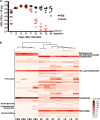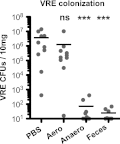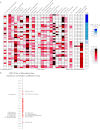Intestinal microbiota containing Barnesiella species cures vancomycin-resistant Enterococcus faecium colonization
- PMID: 23319552
- PMCID: PMC3584866
- DOI: 10.1128/IAI.01197-12
Intestinal microbiota containing Barnesiella species cures vancomycin-resistant Enterococcus faecium colonization
Abstract
Bacteria causing infections in hospitalized patients are increasingly antibiotic resistant. Classical infection control practices are only partially effective at preventing spread of antibiotic-resistant bacteria within hospitals. Because the density of intestinal colonization by the highly antibiotic-resistant bacterium vancomycin-resistant Enterococcus (VRE) can exceed 10(9) organisms per gram of feces, even optimally implemented hygiene protocols often fail. Decreasing the density of intestinal colonization, therefore, represents an important approach to limit VRE transmission. We demonstrate that reintroduction of a diverse intestinal microbiota to densely VRE-colonized mice eliminates VRE from the intestinal tract. While oxygen-tolerant members of the microbiota are ineffective at eliminating VRE, administration of obligate anaerobic commensal bacteria to mice results in a billionfold reduction in the density of intestinal VRE colonization. 16S rRNA gene sequence analysis of intestinal bacterial populations isolated from mice that cleared VRE following microbiota reconstitution revealed that recolonization with a microbiota that contains Barnesiella correlates with VRE elimination. Characterization of the fecal microbiota of patients undergoing allogeneic hematopoietic stem cell transplantation demonstrated that intestinal colonization with Barnesiella confers resistance to intestinal domination and bloodstream infection with VRE. Our studies indicate that obligate anaerobic bacteria belonging to the Barnesiella genus enable clearance of intestinal VRE colonization and may provide novel approaches to prevent the spread of highly antibiotic-resistant bacteria.
Figures






Similar articles
-
Cooperating Commensals Restore Colonization Resistance to Vancomycin-Resistant Enterococcus faecium.Cell Host Microbe. 2017 May 10;21(5):592-602.e4. doi: 10.1016/j.chom.2017.04.002. Cell Host Microbe. 2017. PMID: 28494240 Free PMC article.
-
Gut Microbiota Predict Enterococcus Expansion but Not Vancomycin-Resistant Enterococcus Acquisition.mSphere. 2020 Nov 18;5(6):e00537-20. doi: 10.1128/mSphere.00537-20. mSphere. 2020. PMID: 33208515 Free PMC article.
-
Distinct but Spatially Overlapping Intestinal Niches for Vancomycin-Resistant Enterococcus faecium and Carbapenem-Resistant Klebsiella pneumoniae.PLoS Pathog. 2015 Sep 3;11(9):e1005132. doi: 10.1371/journal.ppat.1005132. eCollection 2015 Sep. PLoS Pathog. 2015. PMID: 26334306 Free PMC article.
-
Enlisting commensal microbes to resist antibiotic-resistant pathogens.J Exp Med. 2019 Jan 7;216(1):10-19. doi: 10.1084/jem.20180399. Epub 2018 Oct 11. J Exp Med. 2019. PMID: 30309968 Free PMC article. Review.
-
[Vancomycin resistant enterococci in the Netherlands].Ned Tijdschr Geneeskd. 2004 May 1;148(18):878-82. Ned Tijdschr Geneeskd. 2004. PMID: 15152389 Review. Dutch.
Cited by
-
Impact of industrial production system parameters on chicken microbiomes: mechanisms to improve performance and reduce Campylobacter.Microbiome. 2020 Sep 9;8(1):128. doi: 10.1186/s40168-020-00908-8. Microbiome. 2020. PMID: 32907634 Free PMC article.
-
Compilation of longitudinal microbiota data and hospitalome from hematopoietic cell transplantation patients.Sci Data. 2021 Mar 2;8(1):71. doi: 10.1038/s41597-021-00860-8. Sci Data. 2021. PMID: 33654104 Free PMC article.
-
Public health evolutionary biology of antimicrobial resistance: priorities for intervention.Evol Appl. 2015 Mar;8(3):223-39. doi: 10.1111/eva.12235. Epub 2014 Dec 11. Evol Appl. 2015. PMID: 25861381 Free PMC article.
-
Helicobacter pylori infection associates with fecal microbiota composition and diversity.Sci Rep. 2019 Dec 27;9(1):20100. doi: 10.1038/s41598-019-56631-4. Sci Rep. 2019. PMID: 31882864 Free PMC article.
-
The Gut Microbiota and Hematopoietic Stem Cell Transplantation: Challenges and Potentials.J Innate Immun. 2019;11(5):405-415. doi: 10.1159/000492943. Epub 2018 Oct 4. J Innate Immun. 2019. PMID: 30286447 Free PMC article. Review.
References
-
- Snitkin ES, Zelazny AM, Thomas PJ, Stock F, Comparative Sequencing Program NISC. Henderson DK, Palmore TN, Segre JA. 2012. Tracking a hospital outbreak of carbapenem-resistant Klebsiella pneumoniae with whole-genome sequencing. Sci. Transl. Med. 4: 148ra116 doi:10.1126/scitranslmed.3004129 - DOI - PMC - PubMed
-
- Ubeda C, Taur Y, Jenq RR, Equinda MJ, Son T, Samstein M, Viale A, Socci ND, Van Den Brink MR, Kamboj M, Pamer EG. 2010. Vancomycin-resistant Enterococcus domination of intestinal microbiota is enabled by antibiotic treatment in mice and precedes bloodstream invasion in humans. J. Clin. Invest. 120: 4332–4341 - PMC - PubMed
-
- Taur Y, Xavier JB, Lipuma L, Ubeda C, Goldberg J, Gobourne A, Lee YJ, Dubin KA, Socci ND, Viale A, Perales M- A, Jenq RR, van den Brink MRM, Pamer EG. 2012. Intestinal domination and the risk of bacteremia in patients undergoing allogeneic hematopoietic stem cell transplantation. Clin. Infect. Dis. 55(7): 905–914 - PMC - PubMed
-
- Freter R. 1955. The fatal enteric cholera infection in the guinea pig, achieved by inhibition of normal enteric flora. J. Infect. Dis. 97: 57–65 - PubMed
Publication types
MeSH terms
Substances
Grants and funding
LinkOut - more resources
Full Text Sources
Other Literature Sources
Molecular Biology Databases

